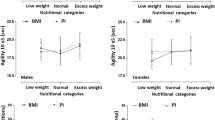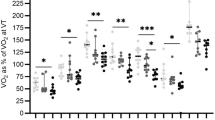Summary
The physical working capacity (W 170) of 38 boys and 27 girls at the age between 8 and 16 years was investigated. Simultaneously the potassium content of the body representing the body cell mass was determined using the40 K-method.W 170 was correlated with the results thus obtained, as well as with body weight and body height. The best correlations were found betweenW 170 and the potassium content. Minimal differences between the sexes were observed. Possible causes for these differences are discussed.
Similar content being viewed by others
References
Berg, K.: Adaptation in cerebral palsy of body composition, nutrition and physical working capacity at school age. Acta paediat. (Uppsala), Suppl.204 (1970).
Burmeister, W.: Potassium-40-content as a basis for the calculation of body cell mass in man. Science148, 1336 (1965).
Cheek, D. B.: Human growth. Philadelphia: Lea & Febiger 1968.
Forbes, G. B., Gallup, J., Hursh, J. B.: Estimation of total body fat from potassium-40 content. Science133, 101 (1961).
Graystone, J. E.: Creatinine excretion during growth. In: Cheek, p. 182 (1968).
Màček, M., Vávra, J., Zika, K.: The comparison of the W170 values during growth. J. Sport Med. (Torino)11, 69–74 (1971).
Mocellin, R., Rutenfranz, J.: Methodische Untersuchungen über die Bestimmung der körperlichen Leistungsfähigkeit (W170) im Kindesalter. Z. Kinderheilk.108, 61–80 (1970).
Mocellin, R., Rutenfranz, J., Singer, R.: Zur Frage von Normwerten der körperlichen Leistungsfähigkeit (W170) im Kindes- und Jugendalter. Z. Kinderheilk.110, 140–165 (1971).
Müller, E. A., Olech, K. H.: Eichkontrolle für das permenentmagnetisch gebrennte Fahrradergometer nach E. A. Müller. Arbeitswissenschaft3, 176 (1964).
Pařizkova, J., Šprynarova, S.: Longitudinal study of the changes of body composition, bodybuild and aerobic capacity in boys of different physical activity from 11–15 years. 2. Internationales Seminar für Ergometrie. Institut für Leistungsmedizin, Berlin S. 115 (1967).
Reba, R. C., Cheek, D. B., Leitnaker, F. C.: Body potassium and lean body mass. In: Cheek, p. 165 (1968).
Roessle, R., Roulet, F.: Maß und Zahl in der Pathologie. Berlin-Wien: Springer 1932.
Romahn, A., Burmeister, W.: Gesamtkaliumbestimmung bei Säuglingen und Kleinkindern mit einem Babycounter. Arch. Kinderheilk.180, 239 (1970).
Rutenfranz, J.: Entwicklung und Beurteilung der körperlichen Leistungsfähigkeit bei Kindern und Jugendlichen. Basel-New York: Karger 1964.
Rutenfranz, J., Mocellin, R.: Untersuchungen über die körperliche Leistungsfähigkeit gesunder und kranker Heranwachsender. I. Bezugsgrößen und Normwerte. Z. Kinderheilk.103, 109–132 (1968).
Author information
Authors and Affiliations
Rights and permissions
About this article
Cite this article
Burmeister, W., Rutenfranz, J., Sbresny, W. et al. Body cell mass and physical performance capacity (W170) of school children. Int. Z. Angew. Physiol. Einschl. Arbeitsphysiol. 31, 61–70 (1972). https://doi.org/10.1007/BF00700995
Received:
Issue Date:
DOI: https://doi.org/10.1007/BF00700995




